There is not a predatory fish that swims in freshwater that does not eat at least attempt to eat the ever-reliable lipless crankbait.
I started using them almost two decades ago but originally only in open, deep water but I now use a lipless almost every time I fish, no matter what my target species or the type of area I’m fishing.
A lot of people still have not clued onto the amazing fish-catching abilities of the lipless crankbait.
Some anglers use the excuse that they don’t want to get their expensive offerings snagged but we all know that if you aren’t getting snagged occasionally, you are not in the zone.
You have to be willing to lose the odd lure.
Another reason some fishos shy away from them is that they have used these lures but have done no good. That’s mainly because they did not know how and where to use them properly or just did it in the wrong areas or at the wrong time.
This article won’t address the last two issues because working out where to fish and when is a game of trial and error with so many variables that would take a book to cover.
Put simply, a lipless crankbait is a flat-sided, slim, sinking minnow lure that gets its action not from a bib that produces a body wobble, but from the vibrating instability that rises from its more central tow point and nose weighting. It is often filled with rattles and when retrieved puts out a surprising amount of vibration.
Sinking lures are the most versatile lures you can have in your box because they can fish the entire water column and can be cast, jigged, hopped, rolled or trolled. They come in a number of different sizes and weights and the silent versions are hard to beat on heavily fished waters where the fish often shy away from lures with rattles.
In shallow water and deep water, different lures and strategies are needed to be consistently successful.
In areas under, say, 3m deep I use three retrieves.
This is as easy as it gets. Simply cast your lure out and slowly wind it back to the boat or the bank. When using this retrieve I try to go as slowly as the lure will allow me; you want to feel the lure working, but only just.
Use this retrieve along the edges of weed beds, under overhanging trees, in shallow bays or around submerged timber.
The next retrieve is basically a variation of the slow roll. I use this from a boat when casting back towards the bank. This retrieve is still just a slow roll but it is interspersed with small pauses, which allow the lure to achieve depth again before to slow retrieve is resumed.
The idea with this is to keep the lure very close to the bottom throughout the entire retrieve. It helps to watch your line on the pause and when it goes slack, you know the lure is on the bottom.
The only other retrieve I use in the shallows is the reaction strike retrieve or ‘burn’, which is so easy. Just cast the lure out and retrieve it with a constant, fast crank.
I use this retrieve when searching large areas for active fish and I find by going flat out, it doesn’t give the fish a chance to think about what they’re doing; they simply eat it or they miss out.
This is a great way to fish because the strikes can be violent no matter what your target species is.
My favourite lipless crankbaits for fishing the shallows for trout, redfin, smallish Murray cod, golden perch and bass are: Ecogear VT55 and VT65; 65mm Balista Juggernaut; Rapala 5cm Rippin’ Rap; #2 Trollcraft Prism Murrin; Jackall TN50 and TN60; and the Viva Mazzy Vibe, especially when using the reaction strike burn retrieve.
If targeting Murray cod or big golden perch in the shallows, my lures of choice are the #3 Prism Murrin, 90mm Balista Juggernaut, Asari 89mm Shindo or the Jackall Doozer.
Water that I class as deep is 10’-60’ – rock walls, deep points, open flats or that outside corridor well off the bank (15’-35’) where fish are often found.
For a deep slow roll, as when fishing the shallows cast out but this time allow the lure to sink and then just get that lure ticking over.
If aiming for fish holding mid-water, I generally use a rattling lure to try to get their attention but if they are holding near the bottom, my first option is always the 60mm 19g Jackall Mask Vibe. This lure gets down quickly, stays down there on the retrieve, has an awesome realistic action and is made from a rubber that is silent but also feels very natural to the fish. If they don’t get it on the first go, they keep coming back after striking.
I use this retrieve when targeting Murray cod with rattling lipless like the Asari Karasu, Jackall TN60 and TN70, Mazzy Vibe, #3 Prism Murrin, 90mm Balista Juggernaut and the Asari Shindo.
These lures ride up in the water column when retrieved so after about 10-15 winds of the reel, I allow the lure to sink back to the bottom, or into the strike zone if fishing mid-water, before repeating the process all the way back to the boat.
Quite often when using this retrieve you get hit while your lure is sinking or when it is sitting on the bottom, so be sure to stay in contact with your lure by retrieving the slack in your line as the lure sinks. This way you won’t miss any hits.
I use the hopping retrieve when targeting fish that are primarily hugging the bottom, especially schooled fish.
First lure of choice no matter what I’m targeting is the ever-reliable 19g Jackall Mask Vibe. I cast it well away from the boat and allow it to sink to the bottom, then wind up the slack line so that my rod tip is very close to the water.
From there I lift my rod sharply about 50cm-1m before allowing the lure to sink back to the bottom. I repeat this process all the way back to under the boat, where I often hop it 10-20 times just in case I have fish interested.
You can also use this retrieve with rattling lures but as they are much lighter than the Masks. I use them on light spin gear to help me achieve depth quicker.
So you can see using lipless crankbaits need not be as complicated as some people might have you think. More often than not, the steady slow roll will account for plenty of fish but if this not working, simply mixing it up a little and you should start hooking some fish.
I’ll leave the topic of how to troll lipless crankbaits for another time very soon. In the meantime, I hope this has helped you build confidence to get out there and catch some fish on lipless cranks.
Reads: 3174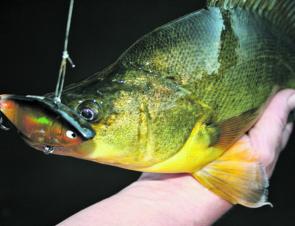
Balista Juggernauts are great when targeting fish in the shallows and work especially well at dusk and dawn.
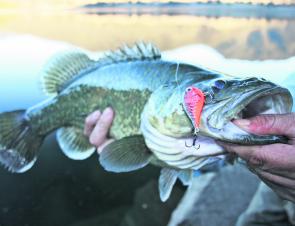
Small lipless crankbaits like this 5cm Rapala Rippin’ Rap also catch big fish, like this Jounama Dam Murray cod. Don’t be too fixated on the lure size; concentrate more on the lure weight and match this to the areas you intend to fish.
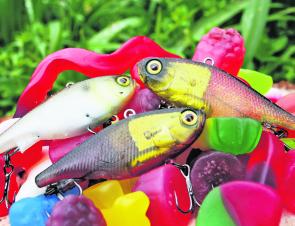
A selection of ‘fish lollies’ for deep predators. These 19g 60mm Jackall Mask Vibes are easily the best lipless crankbaits on the market for targeting fish hugging the bottom in deep water.
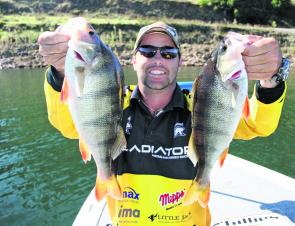
Using the hopping technique described in the article, an angler can exploit schooled fish by keeping the lure in their faces. This retrieve style is very hard to beat when the fish are considered shut down.

Shallow, weedy bays like this are perfect for the lighter lipless crankbaits. The simple slow roll retrieve or a reaction strike ‘burn’ retrieve will get results.
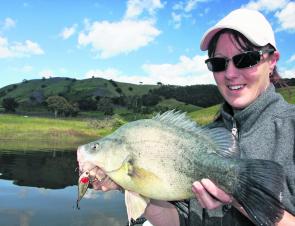
Note the shallow grassy banks in the background. Using a light lipless crankbait like the #2 Prism Murrin with a slow roll was the undoing of this Burrinjuck yella.
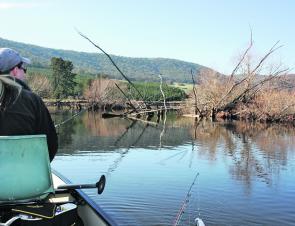
Working shallow timbered areas like this with lipless crankbaits can be a snaggy affair but if you stick to the lighter lures, you will get snagged less and catch more fish.




